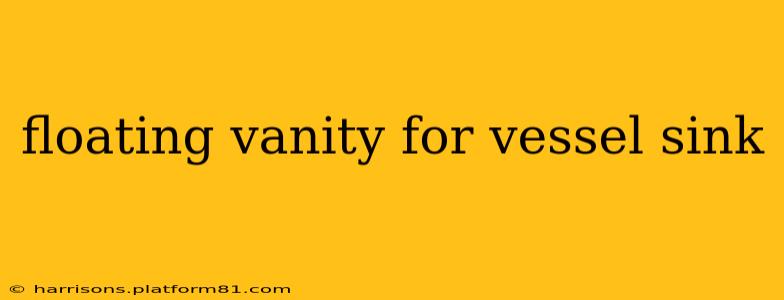A floating vanity with a vessel sink is a stunning addition to any modern bathroom, offering a sleek, minimalist aesthetic and maximizing space. This combination seamlessly blends style and functionality, creating a sophisticated and practical bathroom design. But choosing the right floating vanity and vessel sink requires careful consideration of several factors. This guide will walk you through everything you need to know, answering common questions and providing expert advice to help you make the perfect choice for your bathroom.
What is a floating vanity?
A floating vanity, also known as a wall-mounted vanity, is a bathroom sink cabinet that appears to float on the wall. It's attached to the wall using sturdy brackets, concealing the supporting structure and creating a clean, uncluttered look. This design is particularly popular in smaller bathrooms as it maximizes floor space, making the room feel larger and more open. The absence of legs also creates a contemporary and airy feel, complementing the minimalist design of vessel sinks perfectly.
What is a vessel sink?
A vessel sink, also known as a countertop sink, is a sink that sits on top of the countertop, rather than being installed under it like a traditional sink. This above-counter installation creates a striking visual focal point and adds a touch of elegance to the bathroom. Vessel sinks come in a wide range of materials, shapes, and sizes, allowing for extensive customization to match individual bathroom styles and preferences.
How do I choose the right floating vanity for a vessel sink?
Selecting the right floating vanity and vessel sink combination involves considering several crucial aspects:
1. Size and Scale:
Measure your bathroom carefully to determine the appropriate size for your vanity. Consider the available wall space and the overall dimensions of your bathroom to ensure the vanity doesn't overwhelm the room. The vessel sink should also be proportionate to the vanity's size; a large sink on a small vanity will look awkward, and vice versa.
2. Material and Style:
Floating vanities and vessel sinks are available in a wide array of materials, including wood (like oak, walnut, or bamboo), solid surface materials (like quartz or Corian), and even concrete or metal. Choose materials that complement your existing bathroom décor and are durable enough to withstand daily use. Consider the overall style of your bathroom – modern, traditional, rustic – when selecting the vanity and sink's style and finish.
3. Storage:
While floating vanities offer a sleek look, they often provide less storage than traditional vanities. Assess your storage needs and choose a vanity with sufficient drawers and cabinets to accommodate your toiletries and other bathroom essentials. Consider whether you need open shelving or closed cabinets to maintain a clean and organized space.
4. Faucet Considerations:
Vessel sinks require a specific type of faucet, usually a tall, freestanding faucet that extends high enough to reach over the sink's rim. Consider the faucet's style and finish to complement the overall aesthetic of your vanity and sink. Make sure the faucet you choose has a sufficient reach and clearance above the vessel.
5. Installation:
Installing a floating vanity and vessel sink requires careful planning and execution. Ensure you have the necessary tools and expertise, or consider hiring a professional plumber and installer to guarantee a proper and secure installation.
What are the advantages of a floating vanity with a vessel sink?
- Space-saving design: Floating vanities maximize floor space, making smaller bathrooms feel more open and airy.
- Stylish and modern aesthetic: The combination creates a clean, contemporary look that enhances the overall bathroom design.
- Easy to clean: The lack of legs and baseboards makes cleaning the floor underneath the vanity much easier.
- Customization options: A wide range of materials, styles, and sizes are available to suit individual preferences.
What are the disadvantages of a floating vanity with a vessel sink?
- Limited storage: Floating vanities generally offer less storage than traditional vanities.
- Installation complexity: Installation can be more complex than installing a traditional vanity.
- Potential water damage: Improper installation can lead to water damage behind the vanity.
- Higher cost: Floating vanities and vessel sinks can be more expensive than traditional options.
How much does a floating vanity with a vessel sink cost?
The cost of a floating vanity with a vessel sink varies greatly depending on the materials, size, style, and brand. You can find budget-friendly options, but high-end models can be significantly more expensive. Expect to pay anywhere from a few hundred dollars to several thousand dollars for a complete setup.
Where can I buy a floating vanity with a vessel sink?
Floating vanities and vessel sinks are widely available at various home improvement stores, online retailers, and specialty bathroom showrooms. Research different options to compare prices, styles, and features before making a purchase.
By carefully considering these factors and addressing the common concerns, you can successfully integrate a stunning and functional floating vanity with a vessel sink into your bathroom, transforming it into a stylish and practical oasis. Remember to prioritize quality materials and professional installation to ensure the longevity and beauty of your new bathroom design.
